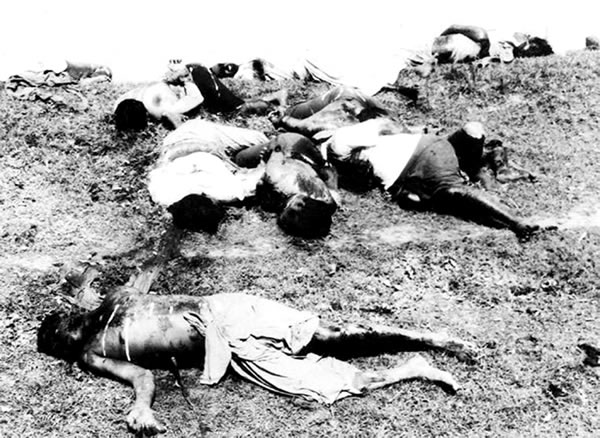 |
| Haitian Massacre (1937) |
For seven bloody days during October 1937, the Dominican army massacred thousands of Haitian men, women, and children living in the northwestern frontier region of the Dominican Republic. Thousands more fled for their lives across the border into Haiti.
Many of the victims were Dominican-born and thus were accorded Dominican citizenship, as guaranteed by the country's constitution. Some came from families that had lived in the Dominican Republic for generations.
The country's president-dictator, Rafael Trujillo, ordered this wave of genocidal violence and justified his actions as an act of national self-preservation, declaring that an invasion of Haitians threatened the Dominican Republic.
  |
Trujillo, reflecting the view of many other Dominicans, defined Dominican national identity according to its difference from Haitians. Dominicans, especially the elite, identified themselves as a white and Hispanic nation, in stark opposition to the black and African Haiti.
The borderlands region dividing Haiti and the Dominican Republic represented a porous boundary marked by a transnational, bilingual, and bicultural community of Haitians and Dominicans, some of whom intermarried.
Unlike Haitians living in the eastern regions of the Dominican Republic, the Haitians in the borderlands were mostly independent small farmers. Many Haitians had immigrated to the Dominican Republic in the second half of the 19th century in search of land in the sparsely populated western region of the country.
Their descendants, although ethnically and culturally Haitian, were born on Dominican soil and considered it their home. The residents of this region did not regard the border between the two countries as a concrete boundary and frequently traveled back and forth several times a day.
The porous and transnational Haiti-Dominican border troubled Trujillo and the Dominican elite, and soon after his rise to power he worked to formalize the border. He feared that the open border provided an easy passageway for exiled revolutionaries to launch an attack on his regime.
Trujillo signed a boundary treaty with Haitian president Sténio Vincent in March 1936. Trujillo and his elite Dominican officials actively engaged in a program of nation building and national identity dedicated to a strict geographic and cultural national boundary between Haiti and the Dominican Republic.
When the massacre began on October 2, both Haitians and Dominicans living in the borderland region feared for their lives, having been caught completely unaware by the killing spree. No policies or actions by the Trujillo regime prior to the massacre had foreshadowed such an event.
Some Dominicans risked their own lives to help their Haitian neighbors, while others aided the army in identifying Haitians. The fluidity of culture and language in this borderlands region made it difficult to distinguish Haitian from Dominican.
Soldiers employed crude methods based on racially constructed stereotypes about Haitians to determine who lived and died, such as determining a person's ethnicity based on their pronunciation of the Spanish "r." The soldiers avoided the use of firearms, preferring machetes, clubs, and bayonets, suggesting to many scholars that Trujillo hoped to characterize the killings as a popular uprising, not government-sponsored genocide.
The massacre forever changed the borderlands region by imposing a strict dichotomy between Haitian and Dominican. Word of the government-sponsored massacre spread quickly as journalists and foreigners reported the atrocities. Trujillo set about creating an atmosphere of anti-Haitian sentiment to justify his military actions.
President Sténio Vincent of Haiti feared a Dominican military invasion and called on the United States, Mexico, and Cuba to act as mediators between the two countries. Trujillo refused to submit to an inquiry, claiming that the incident was not a matter of international concern. The dictator subsequently offered Haiti $750,000 to settle the matter, and President Vincent readily accepted the money.